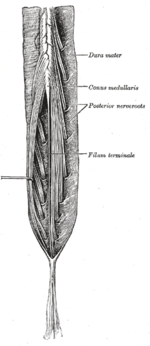Cauda equina syndrome
| Cauda equina syndrome | |
|---|---|
 |
|
| Cauda equina and filum terminale seen from behind. | |
| Classification and external resources | |
| Specialty | Neurosurgery, orthopedics |
| ICD-10 | G83.4 |
| ICD-9-CM | 344.6 |
| DiseasesDB | 31115 |
| eMedicine | emerg/85 orthoped/39 |
| MeSH | C10.668.829.800.750.700 |
Cauda equina syndrome (CES) is a serious neurologic condition in which damage to the cauda equina causes loss of function of the lumbar plexus (nerve roots) of the spinal canal below the termination (conus medullaris) of the spinal cord. CES is a lower motor neuron lesion.
Severe back pain, saddle anesthesia, incontinence and sexual dysfunction are considered "red flags", i.e. features which require urgent investigation.
After the conus medullaris, the canal contains a mass of nerves (the cauda equina or "horse-tail") that branches off the lower end of the spinal cord and contains the nerve roots from L1-5 and S1-5. The nerve roots from L4-S4 join in the sacral plexus which affects the sciatic nerve, which travels caudally (toward the feet). Compression, trauma or other damage to this region of the spinal canal can result in cauda equina syndrome.
The symptoms may also appear as a temporary side-effect of a sacral extra-dural injection:
Any lesion which compresses or disturbs the function of the cauda equina may disable the nerves although the most common is a central disc prolapse. Metastatic disease may also be a cause.
Direct trauma can also cause cauda equina syndrome. Most common causes include iatrogenic lumbar punctures, burst fractures resulting in posterior migration of fragments of the vertebral body, severe disc herniations, spinal anaesthesia involving trauma from catheters and high local anaesthetic concentrations around the cauda equina, penetrating trauma such as knife wounds or ballistic trauma.
CES can be caused by lumbar spinal stenosis, which is when the diameter of the spinal canal narrows. This could be the result of a degenerative process of the spine (such as osteoarthritis) or a developmental defect which is present at birth. In the most severe cases of spondylolisthesis cauda equina syndrome can result.
...
Wikipedia
